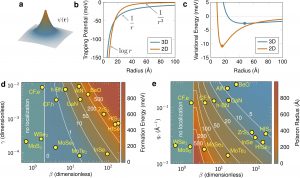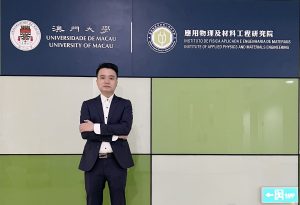UM Macao Fellow Sio Weng Hong in the Institute of Applied Physics and Materials Engineering (IAPME), University of Macau (UM), has made significant progress in a research collaboration with the Department of Physics, University of Texas at Austin. The research team has for the first time observed two-dimensional Frohlich polarons on a boron nitride monolayer, a graphene-like atomic crystal, with the aid of a supercomputer, and predicted the ground state energy of the polarons. The discovery may help design more efficient quantum materials and optoelectronic devices. The research results have been published in the top international journal Nature Physics.
As a class of quasiparticles described under the framework of quantum field theory, polarons are considered to be related to many physical phenomena of materials. It was first predicted by the Soviet physicist, Lev Landau, in the 1930s, and its physical model has been gradually developed by pioneers in high energy physics, such as Nikolay Bogolyubov, Lee Tsung-Dao and Richard Feynman. However, the early formulation of polaron theories mostly used simplified dielectric continuum models in combination with simple mathematical analysis to describe crystal lattices, because of the immaturity of high-performance computers and electronic structure theory in the 1950s. This had led to inaccurate predictions when the early established polaron models were applied to study semiconducting materials.
The research team has established a general framework to compute electron-phonon interactions in both two-dimensional (2D) and three-dimensional (3D) spaces, and clarified the analytical form of long-range interactions between electrons and phonons in 2D materials. Based on this advancement, a new computational method was subsequently proposed to overcome the problem of Coulomb divergence occurred when simulating 2D materials directly with first-principles density functional theory. This method successfully rendered the geometrical details of the polaronic self-trapped state in different 2D hosting materials, and accurately calculated its radius and the ground state energy. Since the existence of lattice defects is commonly found in nature, electrons from dopants that affect the properties of semiconducting materials are often trapped in the defect site to form polarons and induce distortion effects in the hosting material, which in turn renormalises the photoelectric properties of the host. The research results may help engineers design more efficient quantum materials and optoelectronic devices in the future.
In addition, the study proposed a mathematical model of the 2D self-trapped potential, which indicates that the ground state energy of localised polarons in two-dimensional materials depends on three independent physical quantities, namely the effective mass of electron, the effective thickness of 2D material, and the ionic dielectric screening. Its mathematical formula is also given in the article. In addition, the article specifically pointed out that whether an electron in 2D materials can form a localised polaron depends solely on the trade-off between the three physical quantities, and no corresponding laws of physics were found in previous studies of polarons in bulk 3D materials. The proposed model has not only completed the missing piece of modern polaron theories, it is also expected to aid experimental physicists to screen suitable candidates for related studies and provide the required theoretical foundation for practical applications such as superconducting materials, solid-state qubits, single-photon source devices, and photocatalyses. The research results have been published in Nature Physics after a rigorous peer review process.
Titled ‘Polarons in Two-dimensional Atomic Crystals’, the article was co-authored by Dr Sio and the US scientist Feliciano Giustino. The key validation of the discovery was realised by the supercomputer Lonestar 6 at the University of Texas at Austin with thousands of CPU cores. The number of simulated atoms reached 100,000 and the parallel computing program was developed independently by Dr Sio. The study was supported by the UM Macao Fellow scheme of the university and the Science and Technology Development Fund of the Macao SAR (File no: 0102/2019/A2, with Prof Pan Hui providing relevant project resources). In addition, LvLiang Cloud Computing Center in China and the Texas Advanced Computing Center at the University of Texas at Austin provided computing power support for this study. The full-version of the article can be viewed at https://www.nature.com/articles/s41567-023-01953-4.
| Source: Institute of Applied Physics and Materials Engineering | |
| Media Contact Information: | |
| Communications Office, University of Macau | |
| Albee Lei | Tel: (853) 8822 8004 |
| Debby Seng | Tel: (853) 8822 8014 |
| Email: | prs.media@um.edu.mo |


